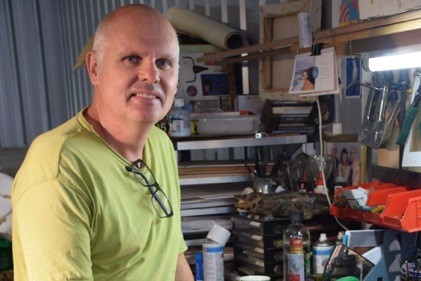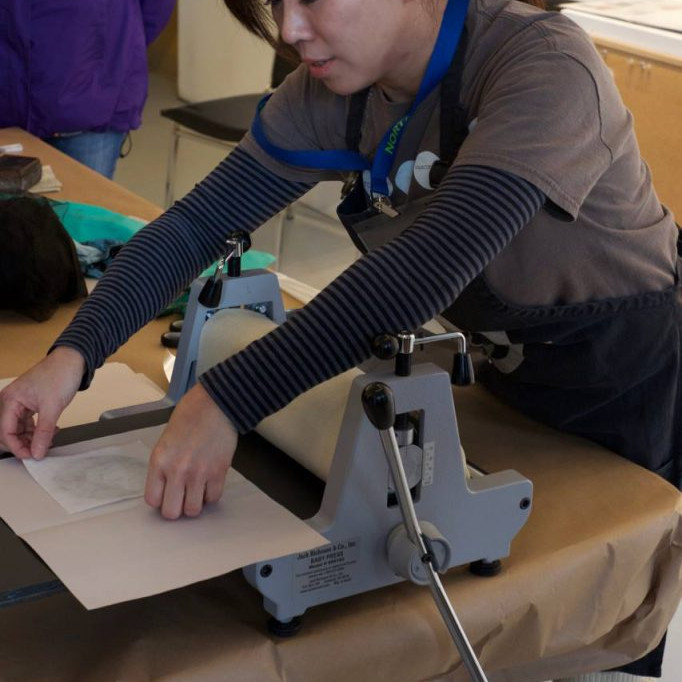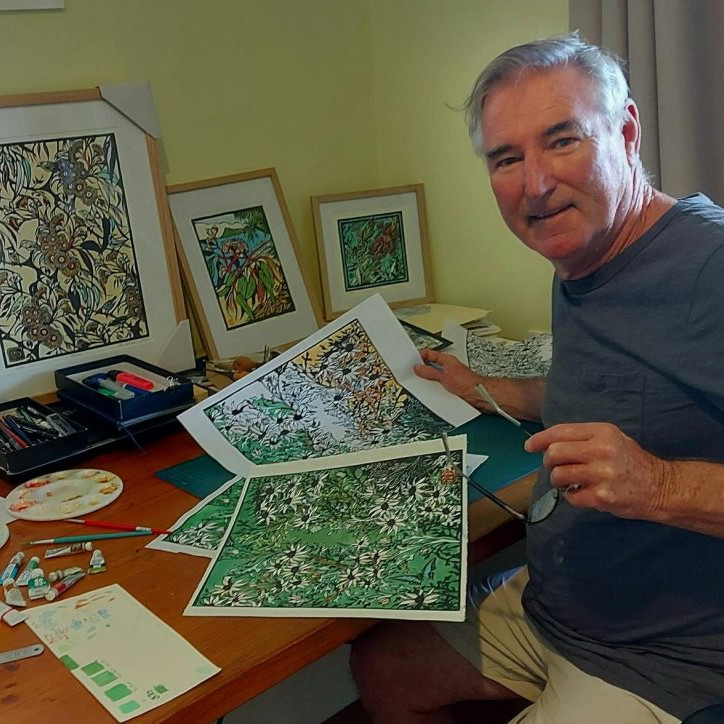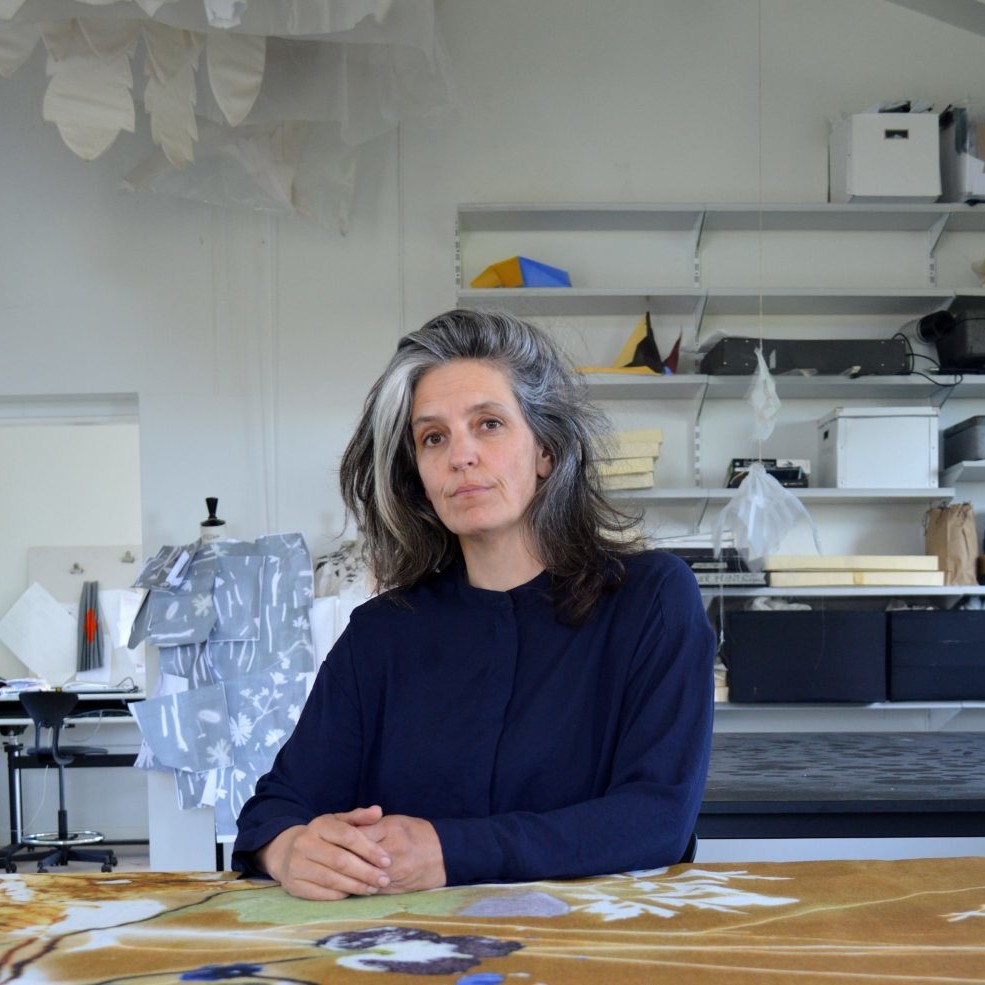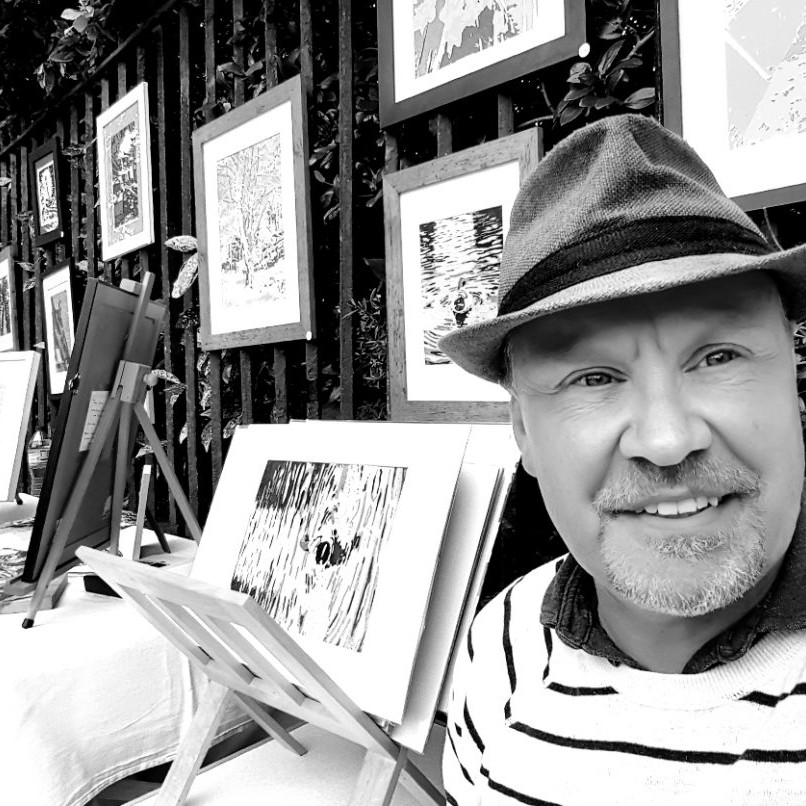Joseph Austin Printmaker - Sydney, Australia
You use copper plate for your prints, discuss briefly
Copper is the best material for etching because its hard and durable, it also has manipulative qualities for the intaglio or engraving process.
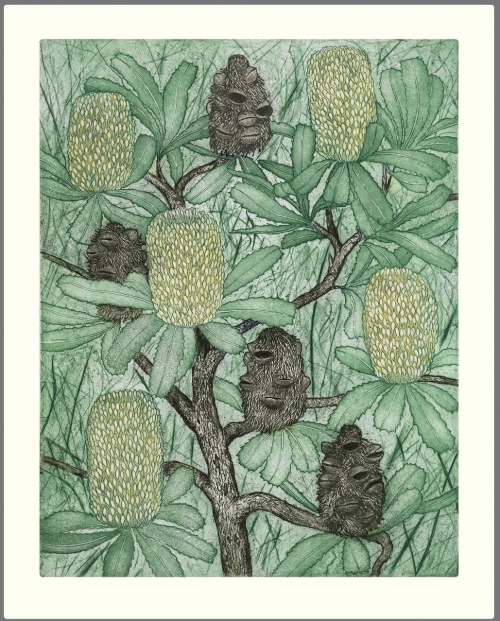
Banksia Old Man
The process
Making and an etching plate involves creating recessed lines and textures into a copper plate. First a polished plate is applied with a layer of acid resistant ground. A general technique of making a design involves drawing through the ground with a fine pointed tool exposing the metal. A modulated surface for tone effects can also be created on a plate. The exposed lines are later ‘etched’ away or corroded by placing the plate in a bath of ferric chloride. Once I’m satisfied with the depths created by the solution it is then wiped away with turpentine revealing an engraved plate. The finished plate can thence be applied with oil based inks for the printing process. When preparing etching plate for printing, ink is thoroughly applied into the etched lines and textures. The excess ink on the plate is then carefully wiped with a special cloth called ‘tarletan’ and final wiping stages can be made with thin paper and cotton buds. Finally the prepared plate is placed on the press bed and soaked art paper is placed over it. It is then moved between two high pressure rollers and a buffer of felt. The paper is moulded into the plate.
Why you especially choose this technique?
I didn’t know what printmaking or etching really was until I took an elective at art school 22 years ago. A lecturer saw my drawings and said printmaking could be my thing. It appealed to me because I like or need to use my hands and etching in very labour intensive. When I begin, I know what I am looking for but the process of making it can take a few twists and turns and you can be surprised with the outcome. After all those years, sometimes I hate it because the longer I do it, more of a perfectionist I have become and that means re-working plates if I’m not happy with. Something I planned to complete in a week ends up being weeks. Reluctant devotion maybe. Luckily ones I go the distance with end up being quite successful. I see the potential and I just keep on going. Sometimes they just fall together.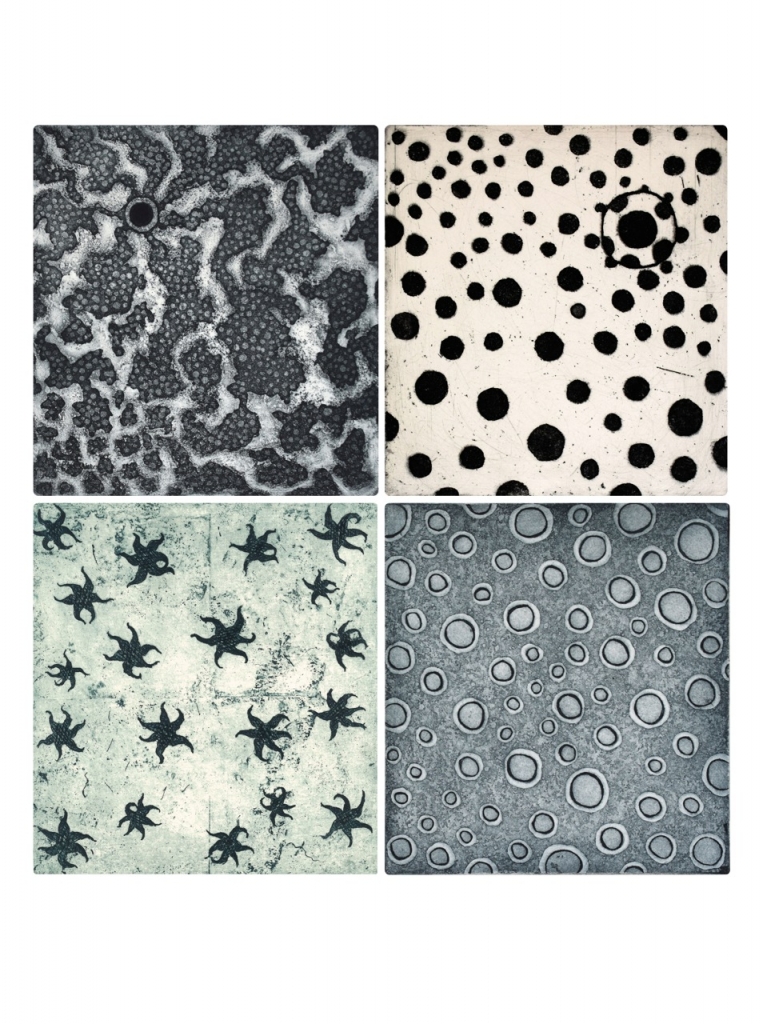
Fish Eyes
How many prints will you take from each plate?
Usually 60. Can’t tell you exactly why. To be honest, I can make some money if its popular. Some I sell the whole edition which is great but then I’m ready to move on with new ideas.
What do you do with the plate at the completion of the Edition?
If an edition has been completed or discontinued, I use the other side for a new work. I once had so many used plates I took them to scrap metal yard. Im not that attached to them but some I keep because in themselves they look nice all polished up… I had one etching with an edition of 60 and it all sold within a year. I could sell that one many times over but once an edition is done its done. I do get asked that Question a lot.
Can you expand on your multi-plate etching?
I use 2-3 plates to construct an image for multi-coloured etchings. I can achieve layered colour effects and isolated colour. It can be much harder because of registration and there are more things to go wrong. If I’m printing multi-plate etching I need to be in the right frame of mind for the day. Nothing worse than spending up to an hour preparing the print only to muck it up wasting time, paper and ink. I”m not that great to be around if the day is going badly…the tones are wrong with my magpies or those lines are overlapping. An unwanted smudge can wreck a print. And it goes. It’s crazy and can be pedantic but like any product it has to made well. Our society is made up of so many components and that also means I can’t have that annoying smudge.
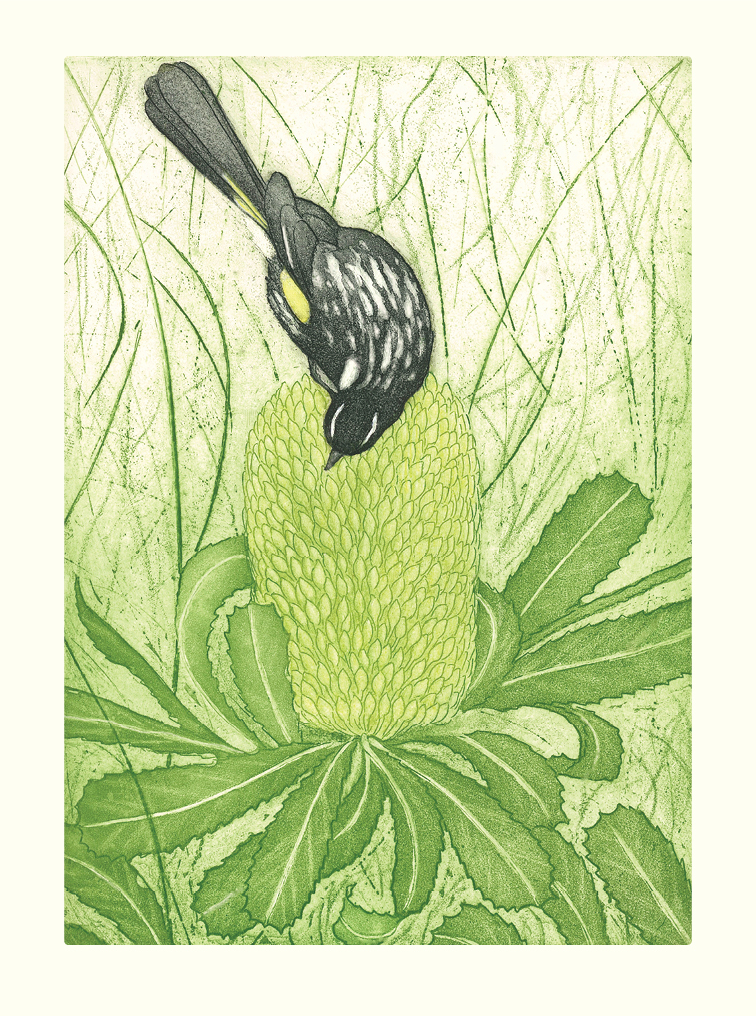 Honey Eater
Honey Eater
Recently you set up your own printing and publishing company, Discuss the process this has taken?
I started making cards about 12 years ago with humble beginnings by selling them at markets. I had some fresh designs but not graphically well produced. I decided a commercial distributor would be good idea and sent them away to 4 companies on spec. Only one answered which was Waterlyn quality cards. They bought all the stock I had, about $3000 and they decided to give them a go in the market place. After eight years they have bought thousands of cards and there in places such as David Jones and Dymocks. They have recently been sold to Henderson greetings which is an international company.
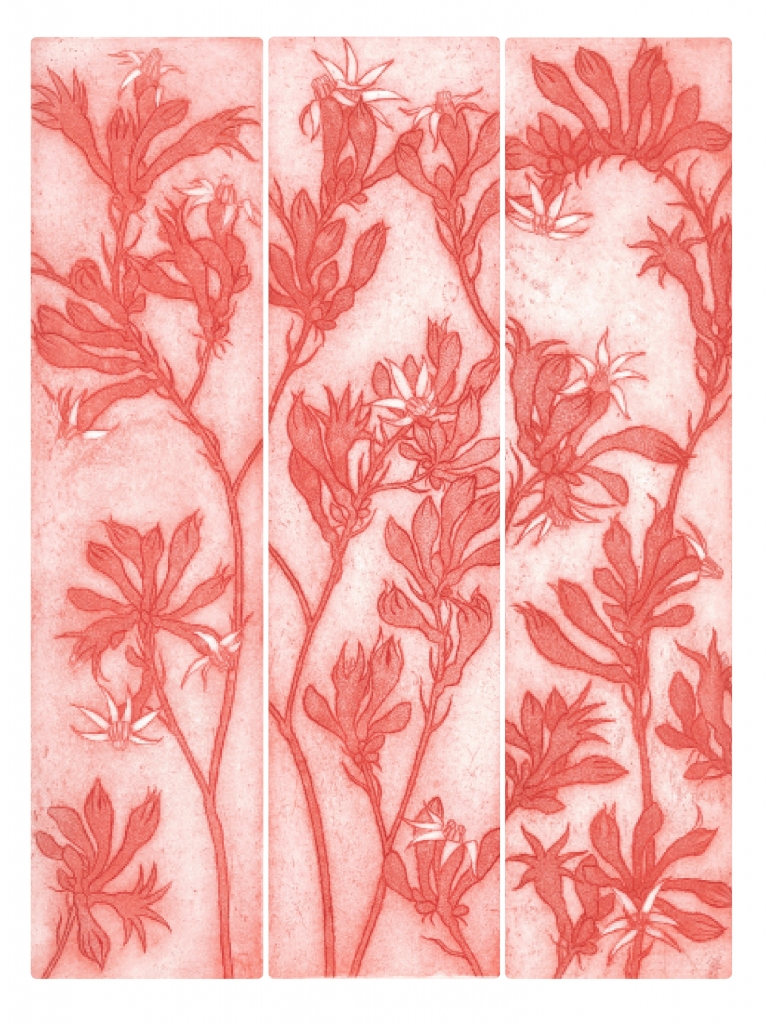 Kangaroo Paw
Kangaroo Paw
Expand on the importance of cards in your art career?
Apart from selling etchings and the occasional painting, greeting cards are my main income. For the past 3 years I have gone into printing my own cards, art-prints and calendars with a Commercial printer I lease. I also invested in finishing equipment such scorers and a commercial guillotine. It’s given me a lot of independence and I can make my products to a standard and cost I need. I can be as finicky as i want without having to rely on a graphic designer or printer. First, I learnt computer design and layout skills at an Adult education course that gave me the confidence to do graphic layouts myself. Once I learnt that I could then do anything. This business model is dependant on my distributor and how much they order. Making art is only a component of my working life then rest is the other part manufacturing, marketing, printing etchings, making frames for my etchings etc. But it all begins with a design idea. It could come from just taking a walk or something and then if something comes to me I would think: Would that make a greeting card? Would people respond to it? Could people be interested in blue bottle jellyfish?
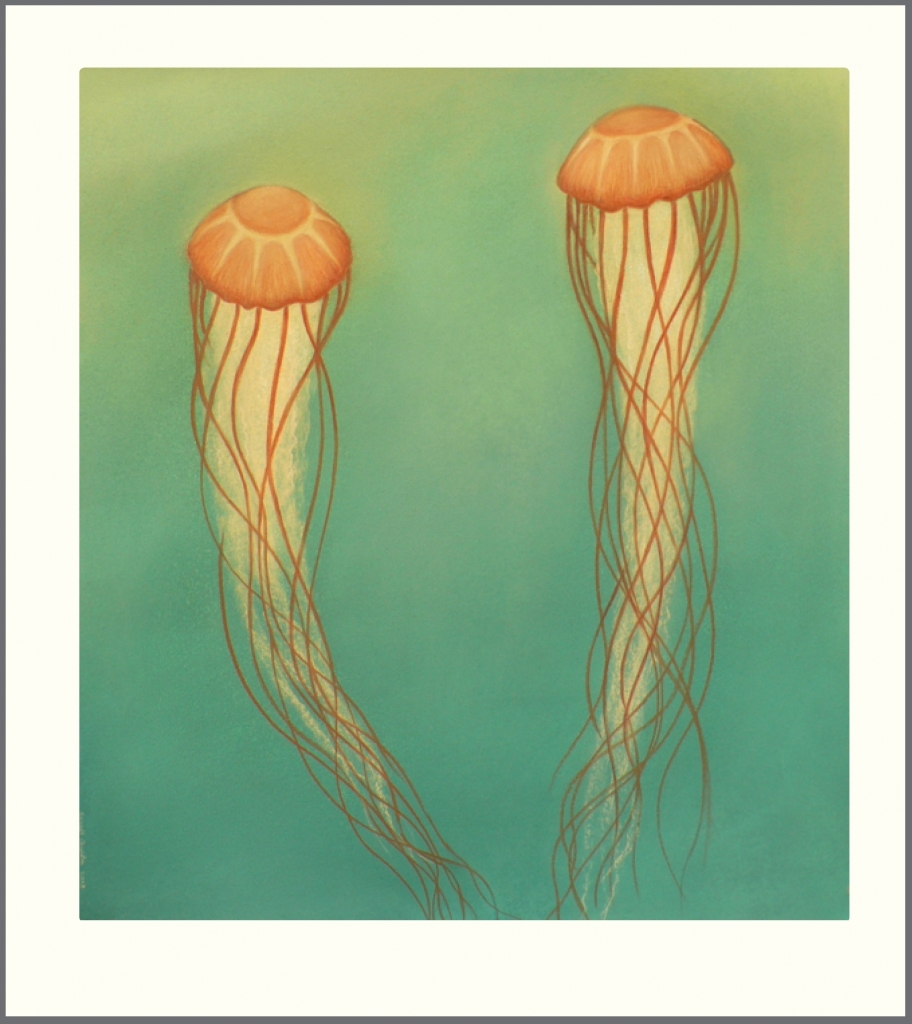
I work to time frames by releasing new designs twice a year for my distributor including August for my calendar.
Discuss your personal thoughts on the importance of hand written cards in our modern society?
It may sound terrible but I hardly ever send them myself. To my mother and sister of course or a special occasion for somebody. Maybe I’m like a fisherman who doesn’t eat fish very often. When I was younger I wrote hand written letters. As for the question; it’s encouraging cards are still popular considering the dominance email and FB are having on the way people communicate. Happy birthday on FB is ok but really what would we rather?
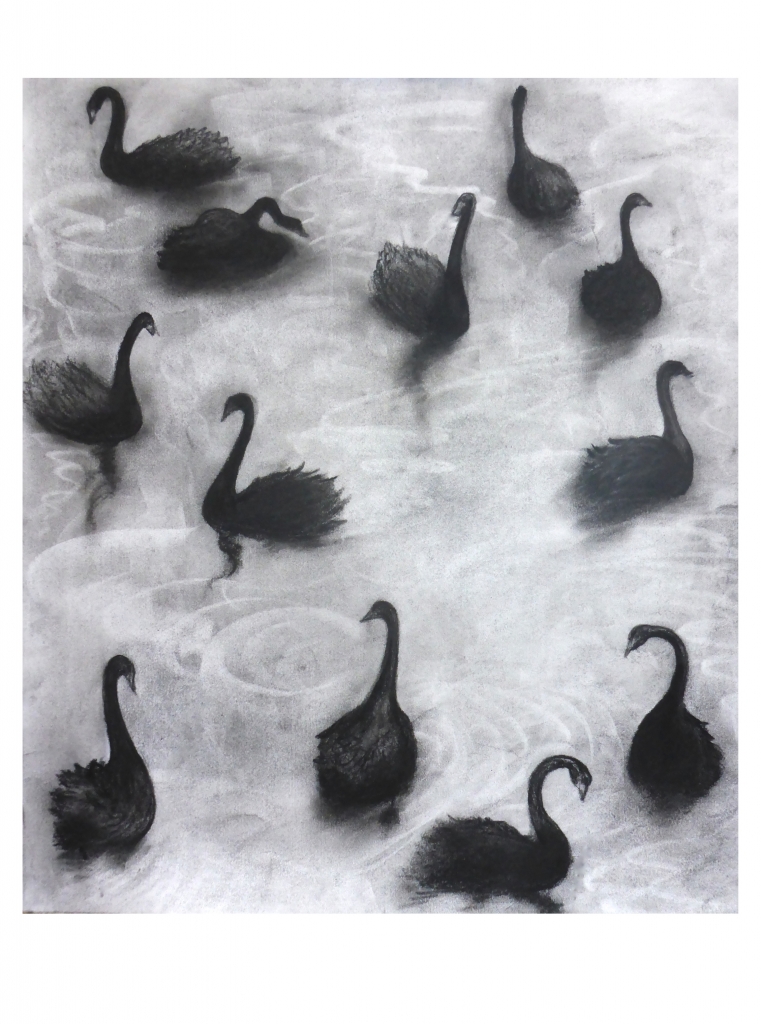
Park Swans, G Card
As a visual artist for me it comes down to a way of getting my pictures seen and generating an income. My pictures have positive content about nature and thousands of people share them. That must be a good thing.
What is the process you put into planning for a new exhibition?
I need a theme and a direction with the materials I am working with. Exhibitions are good for an artist, for me they can generate new ideas and results can evolve from the commitment of producing lots of work. I haven’t put together an exhibition for several years mainly to do with time factors however I’m always open to an opportunity if one arises. We all need to make money so I can’t afford to hang an exhibit in a dud location. That may sound blunt but a fair bit of investment goes into it andthere can be a lot to lose. Not that this hasn’t happen to me in the past. I have had my share of bad choices and some pretty good. Because I mainly make prints, any printmaker will tell you its very hard to get a commercial gallery interested in a suite of limited edition etchings. I guess paintings and other mediums are more likely to generate the income in there business model. That is how I see it. I do better in provincial locations where a gallery will stock my work on an ongoing basis such as my one in Kyneton Victoria, Australia. I think galleries are in sorry state in Australia it must take a lot of business skill to run a successful one. I also don’t have much confidence with many galleries. Maybe because I assume a contemporary printmaking gallery in the inner-city would view my themes as not their thing. I admit this view blocks an aspect of my career which should be going better. I also loath openings all that anticipation on whose is going to show up or buy something. I understand for many artists that social aspect is part of what it’s about and that drives sales and their career. I find it hard to be outgoing in that way. It has not always been so because at art school in Hobart I would go to art openings with friends and I had some fun. My life is Sydney has been rather insular and I know only a few artists.
Can you expand on your work with underwater in relationship to Jellyfish and Coral?
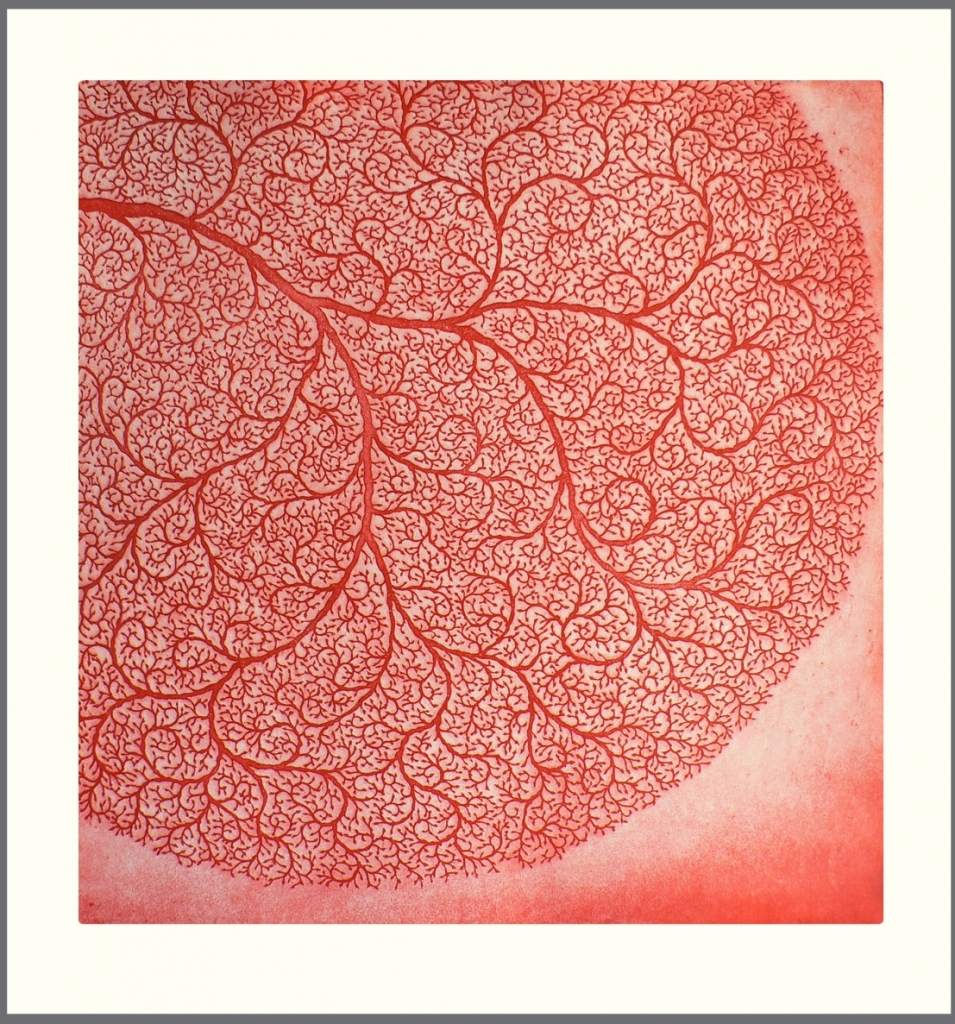
Lace Coral
I’m working on a little sea anemone at the moment with its sensitive tentacles free in its aquatic space. Also an eight legged sea-star bright and visible through cluster of neptunes necklace. One of my hobbies is snorkeling so its a natural subject for me.
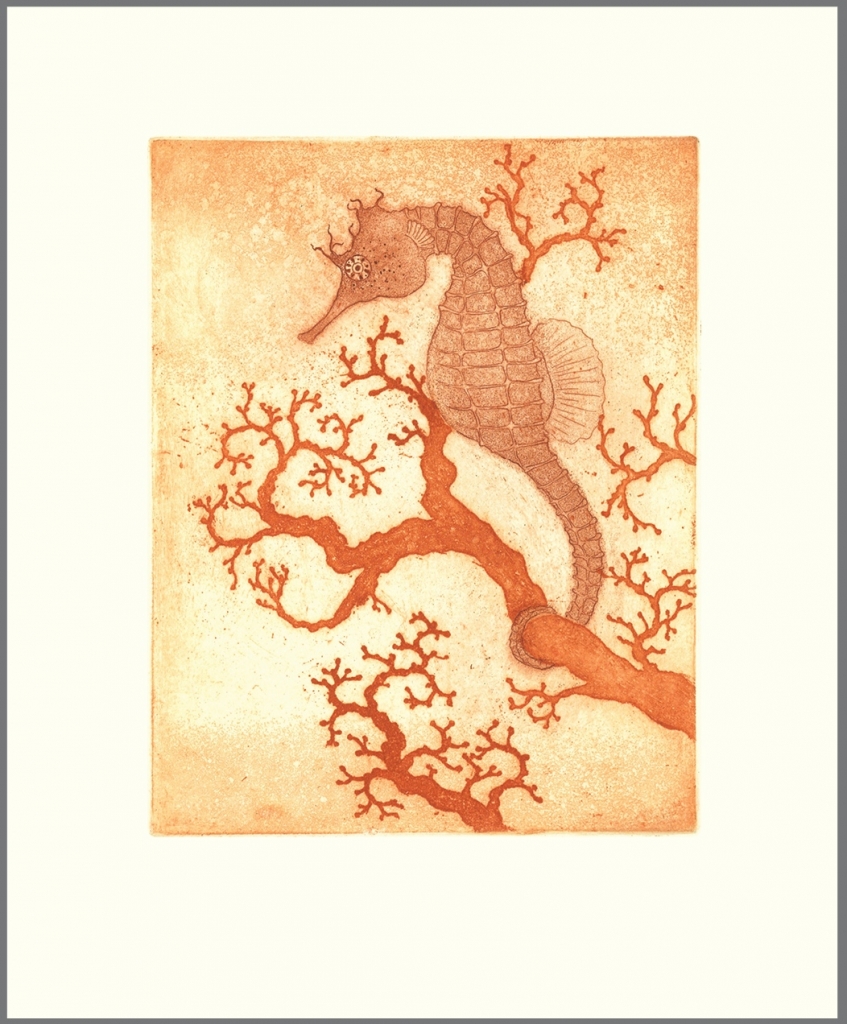
Seahorse and Coral
Discuss the importance of an Australian capturing both Australian flora and fauna?
Since I have been doing Australian nature in my themes I have found an affinity with our plants and animals. It interests me that we are an old continent and our animals and plants have evolved over such a long time to become what they are. I also learn a bit about my subjects and try to bring out their character as a species particularly birds.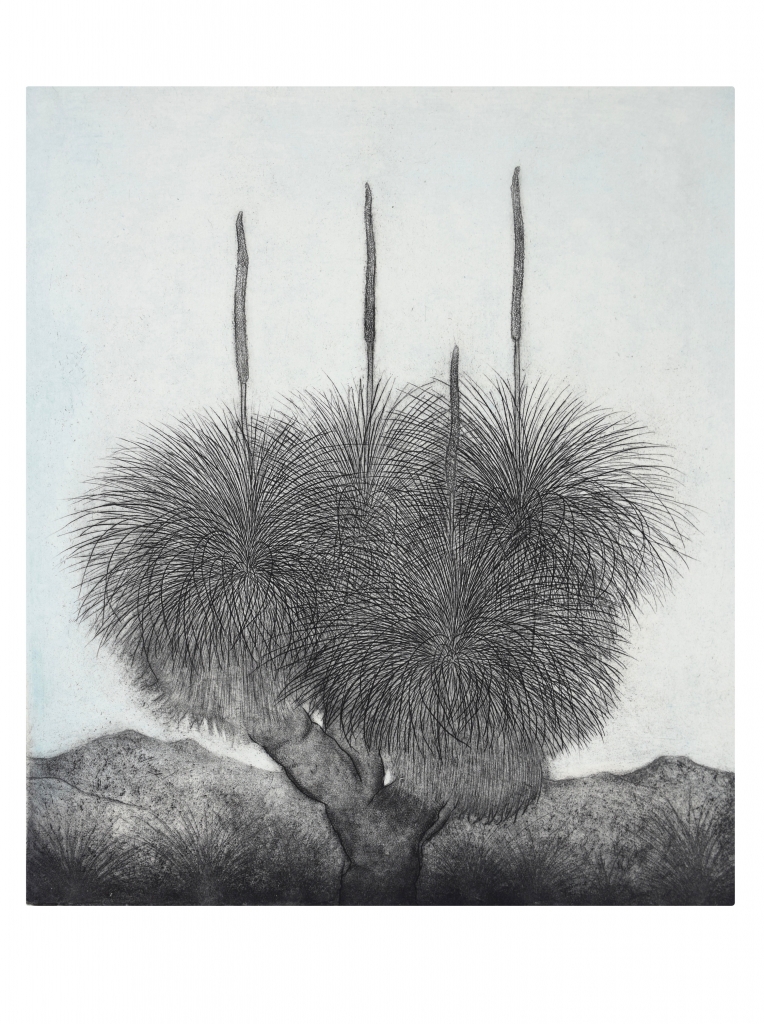
Xanthorrhoea
Explain the amount of sketching needed for capture a bird?
Often from rough sketches. I could do several of the one figure and pick the must suitable. From that I might see and idea for an etching or painting and build. Some times I might have the idea floating around for a year before I start anything. I jot down ideas on a small note book so I never forget its origin. I could be lining up to buy groceries and I would be thinking how my little wren is positioned on that branch. My pictures would unlikely be considered political but I like to think a little native bird on on branch states some sanity in a mad world?

Pacific Black Ducks
Do you use sketch books or photographs as your reference?
I use a combination of everything, whatever to it takes to get my vision for a composition a reality. Sometimes I do a layout on paper or even strait from my imagination on to a etching plate without referencing an thing. I use photos to reference proportions, colour etc mainly for birds and animals. I use my own photos from field trips mainly because I know instinctively what I’m after. The internets handy for learning facts about your subject. Right now I doing some working drawings and layout for a new picture – unravelling ferns . My photos can assist in just getting the rhythms and shapes right for my composition.
Printmaking requires at least one press. Explain the equipment you have and how this has changed over the years?
I bought a old solid press off an artist in Tasmania for $300 22 years ago which I still have. I have had it repaired a couple of times by working it too hard breaking shafts. I have printed hundreds of etchings from it and sold most of them. My mother once said you paid $300 for that! I guess it looked like junk in the back of the ute. But she is one of my biggest supporters.
Discuss your studio area and how it is fitted out to give you the best use?
First impression of my studio could be a crammed mechanical garage not like an artist’s studio you might see on a tv program with their paints and brushes and everything just so. I currently hire a storage space on the ground floor. I have power and ventilation and they let me do my thing there. I am running out of space because in recent years I have accumulated so much stuff- a commercial printing set up, etching press and work benches,framing equipment etc then I have to try and store things. It’s expensive doing anything like this in Sydney and right now I feel like its closing in on me. My wife and I are in the process of moving from our tiny flat in inner-city Paddington and are heading up the coast of NSW away from the confinement and expense. I will be working from home hopefully in a double garage with extra room for drawing and an office. I also want room for a fishing boat.
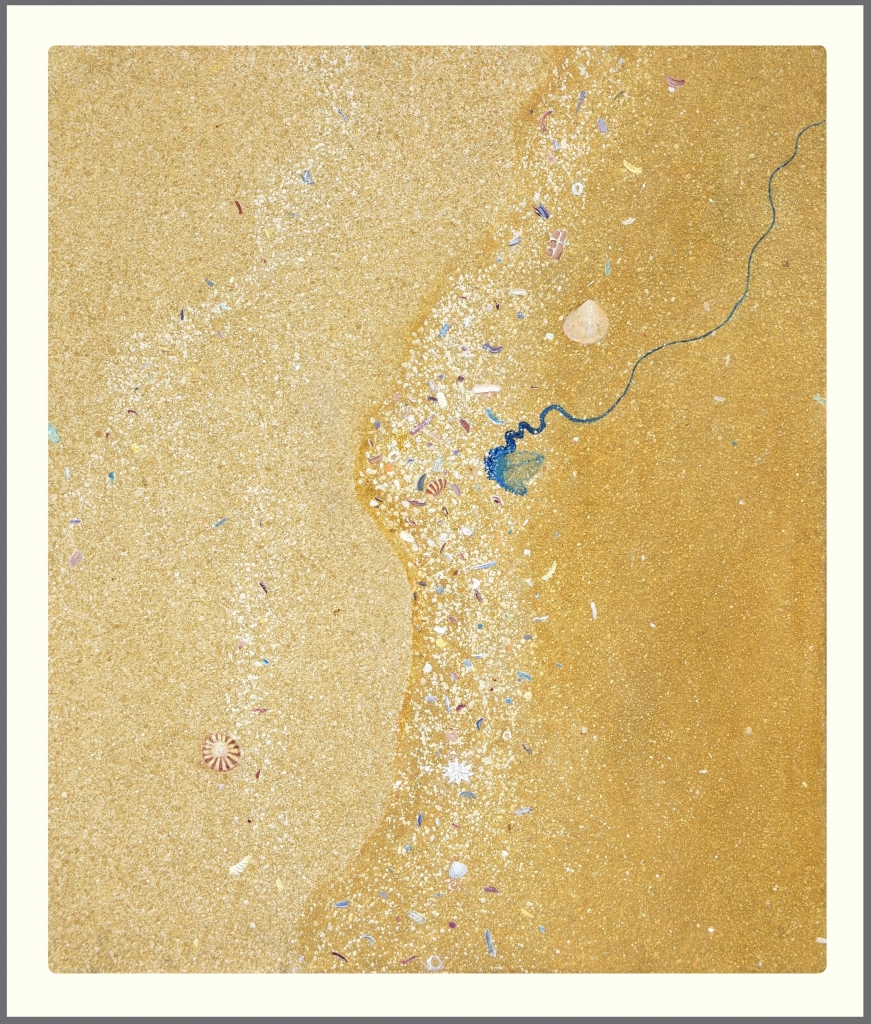
Bluebottle
Contact details:
Joseph Austin
josephart@optusnet.com.au
Joseph Austin, Sydney, Australia
Interview by Deborah Blakeley, April 2017
Think a colleague or friend could benefit from this interview?
Knowledge is one of the biggest assets in any business. So why not forward this on to your friends and colleagues so they too can start taking advantage of the insightful information the artist has given?
Other artists you may be interested in:


